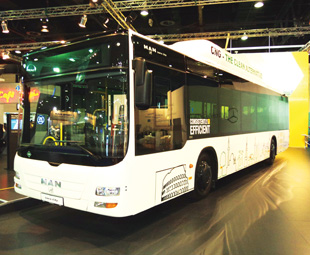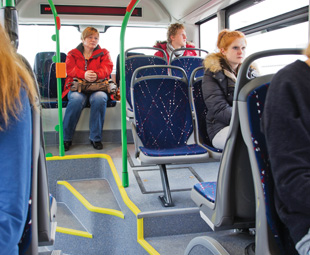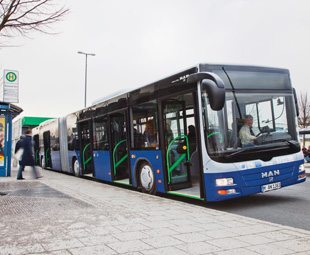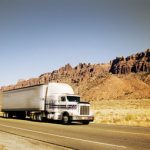MAN stars at UITP

It was impossible to miss MAN Truck & Bus at the UITP. Out and about, the company’s buses were evident trawling the Dubai roads; in the exhibition halls MAN presented an impressive stand showcasing leading-edge technology; and at the congress, bus and coach experts employed by the company also addressed delegates.
First and foremost the stand. The company was promoting the use of compressed natural gas (CNG) – and on show was a brand new version of its Lion’s City CNG, designed especially for very hot countries.
CNG TO THE FORE
But, faced with so many different technologies, the question has to be asked: why CNG? Well, the experts at MAN believe this energy holds considerable potential for a whole bunch of reasons.
The first pertains to sourcing this energy. Extracting, cleaning and transporting the fossil fuel with the lowest carbon content requires comparatively little energy. The specific emission of greenhouse gases by natural gas – calculated for the entire chain of supply, right from the well to the tank – is around 65 grams per megajoule of energy, which makes it almost a quarter less than that of diesel. Although this advantage is to a certain extent cancelled out by the lower efficiency of the natural-gas powered engine relative to the diesel engine as well as by the additional weight of the fuel storage, natural gas still boasts the highest CO2 efficiency of all fossil fuels in the “well-to-wheel” comparison. With the help of bio-natural-gas, the operation of CNG buses can be very nearly CO2-neutral.
 The second reason is the superb combustion characteristics. Natural gas burns very cleanly by comparison with other fossil fuels, so that gas-powered engines emit low levels of air pollutants such as carbon monoxide (50% less than diesel), hydrocarbons (80% less), nitrogen oxides (70% less) and particulate matter (up to 99% less than a diesel engine without a particulate filter). MAN’s CNG-powered buses use this to their advantage and have for several years – and without complex exhaust-gas treatment systems – already been considerably within the limits laid down by the EEV (Enhanced Environmentally-friendly Vehicle) standard, currently the most stringent in the EU. CNG buses also tend to be quieter than their diesel-powered compatriots, thanks to the fact that natural gas is combusted in SI engines.
The second reason is the superb combustion characteristics. Natural gas burns very cleanly by comparison with other fossil fuels, so that gas-powered engines emit low levels of air pollutants such as carbon monoxide (50% less than diesel), hydrocarbons (80% less), nitrogen oxides (70% less) and particulate matter (up to 99% less than a diesel engine without a particulate filter). MAN’s CNG-powered buses use this to their advantage and have for several years – and without complex exhaust-gas treatment systems – already been considerably within the limits laid down by the EEV (Enhanced Environmentally-friendly Vehicle) standard, currently the most stringent in the EU. CNG buses also tend to be quieter than their diesel-powered compatriots, thanks to the fact that natural gas is combusted in SI engines.
The third factor is the security of supply. The world’s assured accessible natural-gas reserves are estimated at almost 190 billion cubic metres. At today’s rate of extraction that’s enough for the next 60 years. If one adds the natural-gas resources (meaning gas that cannot yet be extracted or only with great effort), then the range is around 130 years. At more than 75 billion cubic metres, the world’s biggest deposits of natural gas have been found in the Near and Middle East, followed by Eastern Europe / CIS (62 billion), North, Central and South America (17), Far East/Pacific (15) and Africa (14).
As such, natural gas is being welcomed as an alternative source of energy – for both stationary and mobile applications – in more and more countries around the world. The UAE, for example, decided years ago that natural gas would account for 20% of the total amount of fuel consumed on its roads by the year 2012, and it is well on track to achieving this.
ENTER MAN’S CNG SOLUTION
It therefore made sense for MAN to make a CNG vehicle – a 12-metre long, low-floor solo bus to be precise – the star of its UITP stand. MAN’s new Lion’s City CNG for very hot countries is powered by a turbocharged six-cylinder engine that delivers 228 kW (310 hp) while its emissions are way below the limits set for EEV. The engine’s exhaust gases are especially low when it comes to nitrogen oxides (NOx) and particulates.
The bus boasts a pre-separator for the air-intake system – this is there to ensure reliable operation in very dusty regions where temperatures are high. Power from the natural-gas engine is transmitted to the driving axle by means of an automatic six-speed gearbox equipped with intarder. The gearbox software detects up- and downhill gradients, automatically adjusting the gearshift points as it does so. An additional benefit is that this also reduces fuel consumption.
The natural gas is carried in a total of eight aluminium composite cylinders (rated for a pressure of 200 bar), each with a volume of 214 litres or 1 712 litres in total. The gas cylinders are stored under the attractively designed roof fairing, which can be folded open on both sides, allowing for good accessibility. The storage volume is calculated on the basis of typical inner-city demand, so that the uncomplicated refill procedure can be carried out at the depot in the evening or at night. Alternative packages of cylinders are available on request.
The bright, friendly interior of the Lion’s City CNG – with its 32 seats and standing room for 47 passengers – is easily accessed by means of three outward-swinging sliding doors. Of course, given that the vehicle is particularly designed for countries where temperatures are uncomfortably high, MAN focused on keeping passengers cool under the collar. This has been achieved via the incorporation of a tropical air-conditioning system, which delivers a maximum of 44 kW of cooling performance. Air curtains on the doors also limit the hot outside air seeping into the interior when passengers board and alight at the bus stops. The air curtain system is not new; it’s already being used (with massive success) on the more than 800 buses from MAN Truck & Bus operating in regular service in Dubai and Abu Dhabi.
HYBRIDS ARE HANDY TOO
Of course, MAN hasn’t put all its eggs into the CNG basket. For some time, the company has been enjoying considerable success in the field of hybrid technology, as Tobias Linke, project manager hybrid at MAN Truck & Bus in Munich, told congress delegates. He delivered a paper entitled “MAN Lion’s City Hybrid – a report on initial experiences” which highlighted the reliability, economy and efficiency of this technology.
“Our hybrid bus offers up to 30% lower fuel consumption and CO2 emissions. It is quiet and free of exhaust gases when stationary and when pulling away from bus stops and intersections. Furthermore, it is significantly more efficient than the most modern conventional diesel-powered city bus, but just as safe and reliable,” he noted.
 One of the first pre-series models of the MAN Lion’s City Hybrid was tested as early as 2007 on regular bus routes in Nuremberg, followed by practical operation in Paris and Spain. As of today, the MAN Lion’s City Hybrid prototypes have done way over 100 000 kilometres. Actual field trials have demonstrated fuel savings of up to 30%. “In the course of two-year field trials in Europe, the Lion’s City Hybrid is currently demonstrating its reliability and superior efficiency under the real operating conditions of regular service,” Linke told delegates.
One of the first pre-series models of the MAN Lion’s City Hybrid was tested as early as 2007 on regular bus routes in Nuremberg, followed by practical operation in Paris and Spain. As of today, the MAN Lion’s City Hybrid prototypes have done way over 100 000 kilometres. Actual field trials have demonstrated fuel savings of up to 30%. “In the course of two-year field trials in Europe, the Lion’s City Hybrid is currently demonstrating its reliability and superior efficiency under the real operating conditions of regular service,” Linke told delegates.
The MAN Lion’s City Hybrid has been operating in unrestricted regular service since November 2010, seven days a week, 18 hours a day, within the city of Munich – and Linke revealed that the feedback from staff and passengers had been “highly positive”. “With no gear changes, the vehicle moves smoothly and without jerking. The driving dynamics are excellent, the handling is optimal, the automatic stop/start system is working extremely well, the bus is producing less noise than its diesel-powered equivalent and it’s also yielding 22 to 25% lower fuel consumption,” he pointed out.
BULLISH ABOUT BRT
The company is also bullish about future prospects for bus rapid transit (BRT) systems, as Franz Freiherr von Redwitz, vice-president, MAN Truck & Bus, noted in his presentation to congress delegates, entitled “BRT – the Transport System for Future Metropolises?”
Von Redwitz noted that, in principle, BRT systems offer significant advantages over other inner-city rail systems such as trams and metros. “They can be constructed more quickly and more economically, besides also being far more flexible. BRT systems are relatively easy to integrate into existing urban structures, are not reliant on an exclusive infrastructure end-to-end and are less susceptible to failure when the unforeseen happens (accidents, detours),” he pointed out.
MAN already has considerable experience within the field of BRT systems. “The wide range of bus chassis and complete buses from MAN forms an excellent basis for any BRT system. On top of that there is our recognised competence in providing individual vehicle solutions with the reliability that only a major manufacturer of large-scale series can offer. In several Chinese cities BRT routes are serviced by buses made under licence from MAN/NEOPLAN. In Dubai and Abu Dhabi, in part on bus-only lanes, buses from MAN/NEOPLAN transport thousands of people smoothly and time-effectively to their destinations daily. With our service partners, we also ensure the economical, round-the-clock availability of the vehicles,” Von Redwitz told delegates.
If required, MAN acts as a partner in the consortium that plans, implements and further develops locally adapted BRT systems in conjunction with the vehicle concepts that are suitable in each case. Together with associated partners in the fields of traffic planning, infrastructure and IT, the demands in terms of mobility are determined, the existing infrastructure examined and cost-benefit analyses conducted to establish the basis on which a BRT system for the specific local conditions can be developed and implemented.
 Von Redwitz also spoke about the European research project called the European Bus System of the Future – or EBSF. The European Commission’s biggest road-traffic project to date, the objective of the EBSF is to plan and develop an innovative, high quality and thus attractive bus system for urban local public transport. The EBSF project, under the leadership of the UITP, comprises various sub-projects in which different developmental approaches and options are being tested under real operational conditions in seven European cities. These include optimisation of the driver’s workplace, implementation of new traffic-guidance and passenger-information systems, increase in passenger capacity and flow as well as protection of the environment and energy resources. “MAN Truck & Bus is participating in the activities concerned primarily with increasing the flow of passengers at high volumes and improving the conveyance of those passengers,” Von Redwitz revealed.
Von Redwitz also spoke about the European research project called the European Bus System of the Future – or EBSF. The European Commission’s biggest road-traffic project to date, the objective of the EBSF is to plan and develop an innovative, high quality and thus attractive bus system for urban local public transport. The EBSF project, under the leadership of the UITP, comprises various sub-projects in which different developmental approaches and options are being tested under real operational conditions in seven European cities. These include optimisation of the driver’s workplace, implementation of new traffic-guidance and passenger-information systems, increase in passenger capacity and flow as well as protection of the environment and energy resources. “MAN Truck & Bus is participating in the activities concerned primarily with increasing the flow of passengers at high volumes and improving the conveyance of those passengers,” Von Redwitz revealed.
The Lion’s City GL-type city bus is just one of MAN’s EBSF initiatives – one of these vehicles was recently handed over to the Budapest Transport Company for several months of trial operation. The objective is to gain insights that will enable the design of more efficient, eco-friendly and attractive urban bus systems in future. The MAN Lion’s City GL will serve an inner-city bus route with a particularly large number of passengers. Accordingly, the 18,75-metre long articulated bus has been designed so that even with a high passenger volume, passenger flow will be optimal and thus ensure short stops. For this reason, the Lion’s City GL has for the first time been fitted with five wide doors, while the passenger compartment has been optimised for a large flow of passengers. Moreover, the arrangement of seating in the forebody has been kept flexible.
The demonstrator vehicle from MAN will be tested for several months on the 11 km Line 86 in Budapest’s inner city. The route and  the high passenger volume make it ideal for testing the ground-breaking concept in practice. The line has a total of 46 stops and connects to the two most important tram lines as well as to a station on the underground. Roughly 26 000 passengers use Line 86 in each direction every workday. The Budapest Transport Company has calculated that the average speed of vehicles currently serving this route is 20 km/h, dropping to 15 km/h in heavy traffic. This means that a rapid passenger flow and thus short waits at each stop will make a significant contribution to minimising loop time. The less time needed to serve the route, the more often the route can be served each day, thus improving service to the user.
the high passenger volume make it ideal for testing the ground-breaking concept in practice. The line has a total of 46 stops and connects to the two most important tram lines as well as to a station on the underground. Roughly 26 000 passengers use Line 86 in each direction every workday. The Budapest Transport Company has calculated that the average speed of vehicles currently serving this route is 20 km/h, dropping to 15 km/h in heavy traffic. This means that a rapid passenger flow and thus short waits at each stop will make a significant contribution to minimising loop time. The less time needed to serve the route, the more often the route can be served each day, thus improving service to the user.
Naturally, you will be able to read all about the outcome of the trial right here in FOCUS. Watch this space!
Fast facts: MAN Lion’s City CNG at a glance
Length: 11 980 mm; width: 2 500 mm; height: 3 370 mm; wheelbase: 5 875 mm; seats/standing room: 32/47.
Engine: MAN E2876 LUH 03 (OBD2) with hot-country package; capacity: 12 816 cm³; output: 228 kW (310 hp) at 2 000 r/min; maximum torque: 1 250 Nm at 1 000 to 1 700 r/min.
Gearbox: ZF 6 AP 1400 EcoLife with TopoDyn Life efficiency software and intarder.
Suspension (front): MAN comfort low-floor axle; (rear): ZF portal axle.
Fuel storage: Eight aluminium composite gas cylinders (rated for a pressure of 200 bar) each with a volume of 214 litres.
Mass: empty, approx. 13 000 kg (depending on equipment) / gross vehicle mass (GVM), 18 000 kg.
Published by
Focus on Transport
focusmagsa



